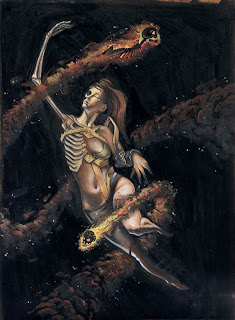Δευτέρα 24 Φεβρουαρίου 2014
bubug (Magdalena)
She is an illustrator from Poland, gothic atmosphere and vivid colours and striking details. Her inspiration seems to come from movies, novels legends and tales of epic and gothic fantasy, like Tim Burton and George Raymond Richard Martin. Visit her sites HERE and HERE
Δευτέρα 17 Φεβρουαρίου 2014
Suehiro Maruo
Suehiro Maruo (1956-) is a Japanese manga artist, illustrator, and painter, notorious for the extreme violence and eroguro illustrations. Though most prominently known for his work as a manga artist, Maruo has also produced illustrations for concert posters, CD covers (e.g. japanese punk rockers Balsac's, album covers), magazines, novels, and various other media. Some of his characters have been made into figures as well. Though relatively few of Maruo's manga have been published outside of Japan, his work enjoys a cult following abroad. Many of Maruo's illustrations depict graphic sex and violence and are therefore referred to as contemporary muzan-e (a subset of Japanese ukiyo-e depicting violence or other atrocities.) Maruo himself featured in a 1988 book on the subject with fellow artist Kazuichi Hanawa entitled Bloody Ukiyo-e, presenting their own contemporary works alongside the traditional prints of Yoshitoshi and Yoshiku. Maruo's nightmarish manga fall into the Japanese category of "erotic grotesque". The stories often take place in the early years of Showa Era Japan. Maruo also has a fascination with human oddities, deformities, birth defects, and "circus freaks." Many such characters figure prominently in his stories and are sometimes the primary subjects of his illustrations.
 |
| used as album cover for Balsac's Dark-ism (2005) |
Δευτέρα 10 Φεβρουαρίου 2014
Hel, the Norse goddess of death
 |
| Hel (1889) by Johannes Gehrts |
 |
| Hel by Karl Ehrenberg (1882) |
 |
| Loki's brood; Hel, Fenrir and Jörmungandr. The figure in the background is presumably Angrboða. (1905) by Emil Doepler |
 |
| Goddesses of the North_Hel by ansfhd |
 |
| "Norse goddess Hel" by Tara Ryzebol |
 |
| http://www.thaliatook.com/index.html |
 |
| Hel by Trishkell |
 |
| Hel In Red by Medusa1893 |
 |
| Hel the goddess of hell-Cd cover by Asgrimson |
 |
| Hel - Der Tod und Das Madchen by WintersKnight |
Δευτέρα 3 Φεβρουαρίου 2014
Lynd Ward
Lynd Kendall Ward (1905 – 1985) was an American artist and storyteller, known for his series of wordless novels using wood engraving, and his illustrations for juvenile and adult books. His wordless novels have influenced the development of the graphic novel. Strongly associated with his wood engravings, he also worked in watercolor, oil, brush and ink, lithography and mezzotint. He was well known for the political themes of his artwork, often addressing labor and class issues. Ιn 1936 an edition of Mary Shelley's Frankenstein was published with illustrations by Ward. Ward's work included an awareness of the racial injustice to be found in the United States. This is first apparent in the lynching scenes from Wild Pilgrimage and appears again in his drawings for North Star Shining: A Pictorial History of the American Negro, by Hildegarde Hoyt Swift, published in 1947. In 1941 his illustrations were used in Great Ghost Stories of the World:The Haunted Omnibus, edited by Alexander Laing.
Εγγραφή σε:
Σχόλια (Atom)






















































.jpg)



